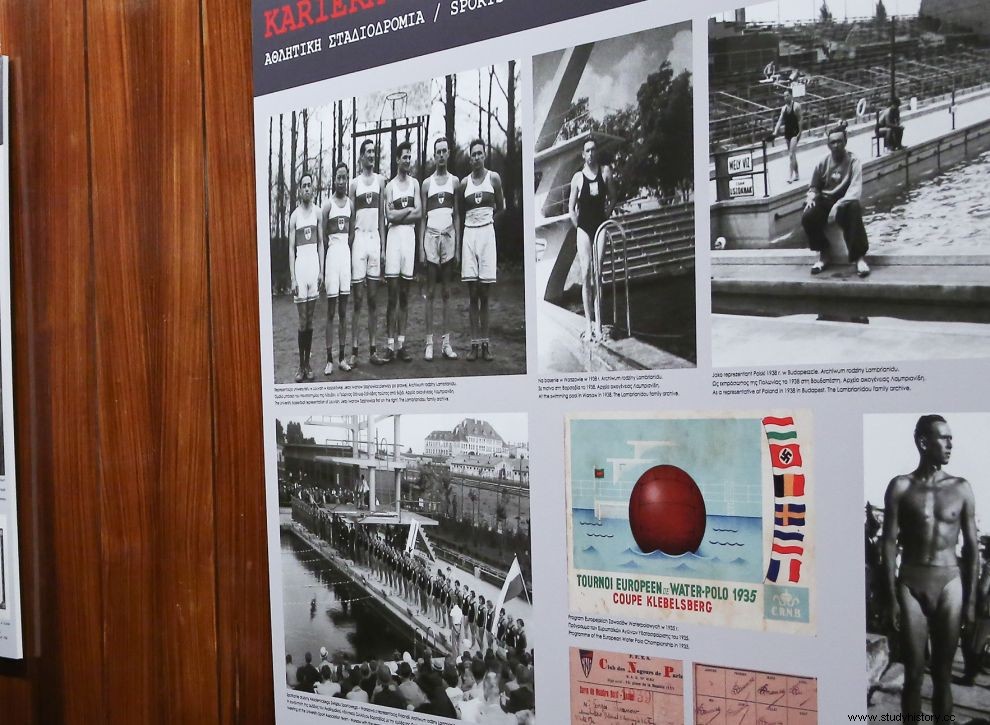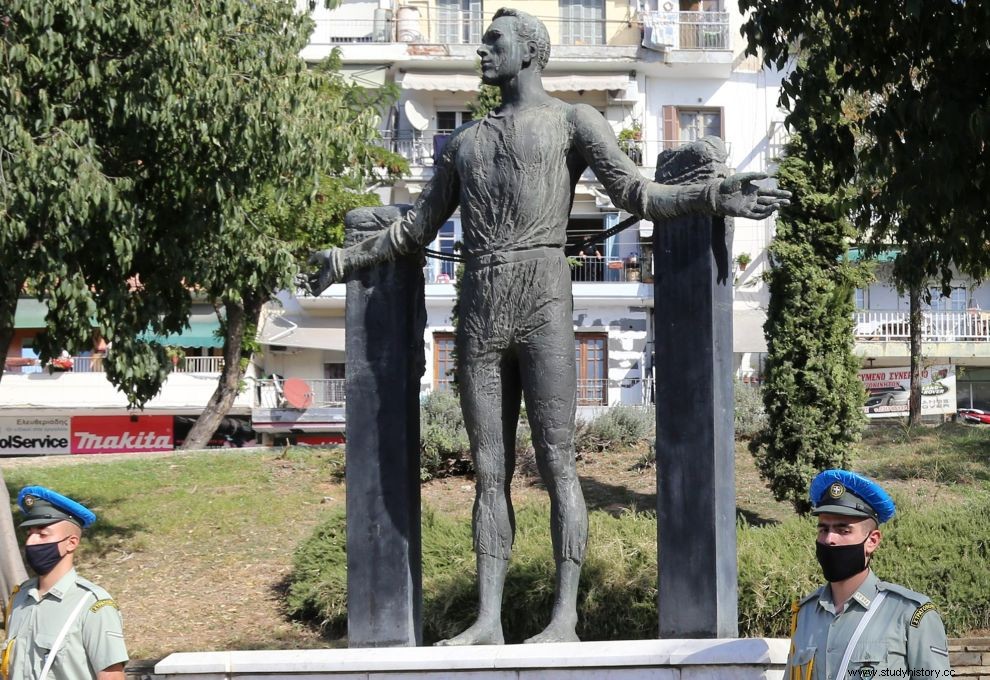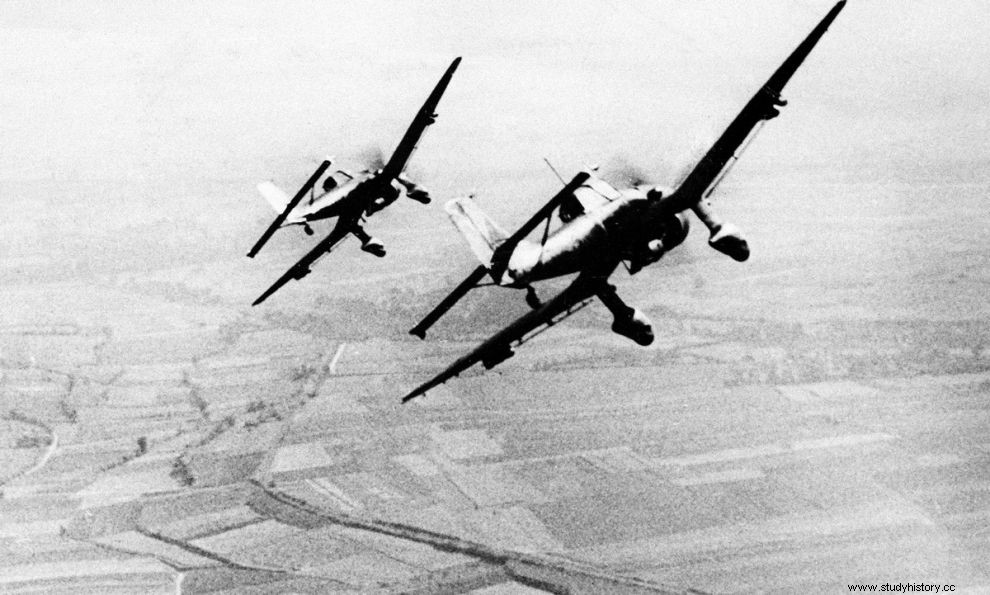On this day 79 years ago (4/1/1943) the German invaders executed Gerzi (Georgio) Ivanov and his Greek associates. The Nazis had sanctioned with 2 million drachmas, one of the greatest (if not the greatest) saboteurs of World War II. The Polish super-athlete of Herakles, who grew up and loved Greece, fell dead, after he tried once more to escape. A gust wounded him in the leg, his executioners tied him to a post and executed him. Before he breathed his last, he had time to shout a cheer for his two homelands. Greece and Poland.
Along with Ivanov, the conquerors also executed his Greek collaborators. They had been arrested in the house of Ioannis Kontopoulos, after betrayal and after the Nazis were frantically looking for those responsible for the sabotage at the Maltsiniotis factory, which cost tens or even hundreds more, damaged planes and while the Lutwaffe was trying to support Rommel's army in North Africa .
A leading sabotage in the annals of the Greek resistance (but also of the entire BPP), for many superior - in the end result - to the blowing up of the Gorgopotamos bridge, which certainly had a greater symbolic character and was carried out by armed resistance groups (ELAS and EDES) in collaboration with British saboteurs.
In the case of PYRKAL (this was the Maltsiniotis factory) the sabotage organized by Ivanov and carried out by the EAM workers (executed a month later in Kaisariani) took place in the city, under the noses of the Nazis, who did not understand that the engines of the Junkers Ju 87 and Stuka planes had irreparable damage shortly after takeoff.
A fascinating story, bordering on myth, could be a nice script for a movie, but it is completely true and almost forgotten, like the whole saga of the Greek resistance to the German occupation.
The fearless super athlete
When George Ivanov was executed, Ivanov as we learned him in Greece (with the spelling of the time), was 32 years old. And he had managed to live ten lives. Born in Warsaw to Count Vladimir Ivanov, an officer in the tsarist army, and Leonarda Zainowicz. Later his mother met Ioannis Lambrianidis, whom she (along with her son) followed to Thessaloniki in 1926.

The erudite young man enrolled in the city's French Lycée, learned Greek and French (while already speaking Polish and Russian) and immediately distinguished himself for his appeal in sports. As a Hercules athlete he excelled in swimming and polo, a sport he also served as a student in Belgium. At the University of Louvain, he studied agriculture-engineering, swam like a torpedo, while playing polo in a team in Warsaw, reaching the position of footman in the Polish National Team.
After Belgium, he found himself in Paris where he continued with postgraduate studies at the Institute of Colonial Agriculture and finally returned to Greece. Seeing the Nazis occupy both of his homelands, the flame of liberation flared up in him. When he hosts members of Polish resistance organizations in his house, the idea of joining them in the Middle East enters his mind. His family reacts, but the risk-taking and fearless Ivanov leaves one day, first for Athens and then for Palestine, where he presents himself to the Polish army.
His athletic background, however, combined with the languages he spoke had made him an ideal model for a secret agent. His training was undertaken by the British SOE (Special Operations Executive) and on October 13, 1941, the English submarine Thunderbolt landed him on the coast between Agios Andreas and Nea Makri. His mission is to organize resistance groups and do as much sabotage as he can. It turns out to be a smallmouth bass, after first it almost destroyed everything. A childhood friend betrays him to the Germans, who arrest him. Ivanov escapes, is rewarded with 500,000 drachmas, but manages to find trusted people and start his headquarters.
He comes into contact with Ioannis Kontopoulos and Vassilis Maliopoulos. Both Navy officers, who had founded the Genus Resistance Organization and who provide him with shelter and information. Ivanov takes a job at the Skaramanga shipyards under the name Kyriakos Parissis and begins his daring actions.
On March 14, 1942, the day the "occupation loan" was signed (that is, the theft of more than 200 million marks, which Greece was obliged to pay to the occupiers, on loan and without money, of course), Inov blew up the submarine U-133, outside the Salamis.
In May, he sabotages the Spanish steamer San Isidore, which was smuggling for the Germans. The ship sinks in the port of Piraeus. Three months later, he places a magnetic mine on another submarine (U-372) which is then sunk by the Allies. The news that Benito Mussolini was planning to visit Athens motivates him to prepare the assassination of the Duce. The fully developed plan is never implemented, since the Italian dictator never comes to Greece.
Already, however, another act of sabotage has begun, which was to be one of the greatest acts of sabotage ever committed in conquered Europe.

There near Hymettos...
The Maltsiniotis factory, PYRKAL in other words, is an emblematic place for Ymittos. The majority of the residents of the area worked there, before and after the second world war. Three of my mother's four sisters passed through the gate, which still stands, half-demolished shortly before the site was completely expropriated for the relocation of nine Ministries, as defined by the area's new "upgrade plan" (we say now).
The Maltsinioti brothers were selling guns and cartridges in Monastiraki in 1887, a year later they moved to Psychiko and in 1890 they bought the land known to those who live in the municipality of Ymittos-Dafni.
The competition with "Hellenic Pulp Factory SA" was very intense. A war in other words for the orders of material from the state, which only stopped when they were merged and transformed into the Company of Hellenic Silicate and Canning Company. In the beginning, the original EEPK and EPK were used, then PYRKAL was established.
However, even when the company passed into the hands of Prodromos Bodosakis-Athanasiadis, the Ymittiotes always referred to the Maltsiniotis factory. The factory and all its equipment was handed over to the Nazis (total cost incalculable) when the swastika was raised on the Acropolis. Bodosakis had managed to leave occupied Greece, with the Germans prioritizing the repair of the engines of the planes they used in their operations in North Africa.
The conquered Greeks will not bow down easily. Resistance organizations are springing up quickly, with the National Liberation Front leading the way. EAM organizes an unprecedented network and from one point on it is everywhere. The Maltsiniotis factory could not be an exception. Giorgos Kollenimos from Byron and Aurylios Varkados are taking the lead in creating the EAM core.
Giorgos Ivanov's team will contact him, so that the sabotage inside the factory can be completed. It is said, without having been ascertained whether this is a truth or a myth, that the Greek-Polish saboteur used to frequent a cafe, outside the main gate, clean-shaven and wearing blue glasses, pretending to be an Armenian homeless person. In this guise, he allegedly orchestrated the sabotage plan.
What were they putting in the engines
The EAMite workers together with their fellow travelers begin the sabotage, which for some time has been an unsolved mystery for the Germans. Almost magically, while the planes' engines apparently passed quality control so they were ready to be assembled into the Jungers and Stukas, they were actually scheduled to be destroyed on takeoff!
Leonarda Lambrianidou, the niece of Giorgos Ivanov, told "Nea" three years ago that the saboteurs threw iron shavings into the engine, which could not be detected in the inspection before the engines were delivered for use.
Veteran communist Nikos Karathanos in the book "History of the Resistance 1940-45" narrated his own version:test with this engine and it does a maneuver or a turn. All airplanes do a turn test, a reverse they say. So they put nuts (a metal part that screws around a screw) into the engine after quality control and just before assembly.

These nuts, because they are heavy, when the plane is in straight flight are at the bottom, in the cockpit, but when the plane flipped over, they would turn upwards, the crankshaft, the shaft would grab them and so the engine would break. In this way they did a lot of sabotage, they destroyed 65 engines and as a result many enemy planes were shot down and dozens of German airmen were lost, but they were finally discovered, by accident. One plane was not destroyed and the Germans found in the engine the nuts that our people had dropped"
Ioanna Tsatsou, in her emblematic book-diary "occupation leaves", hosts the story of the mother of Ilias Alevizakis, one of the protagonists of the sabotage:"These days a hazy anxiety reigned in the requisitioned factory of Maltsiniotis. The Germans were upset. The airplane engines manufactured by the factory were not working normally. Ilias Alevizakis together with Vassilis Ioannidis and Varkados, all three workers, went to work in the morning with their mouths open full of metal debris. These debris were blown into the airplanes' engines. Airplanes would crash or not start. Engines would be destroyed.
The Germans stubbornly sought to find the cause of the evil. They had taken apart over thirty engines to make sure they all had the same chipped plates. Alevizakis knew that he would be caught and could leave. But he adored his mother. He loved her and felt sorry for her. He saw her every day fighting alone, from dawn, for his five minor brothers. She trembled lest harm should come to her. He made him sick for a few days. But when they went to catch him, he surrendered".
The extent of the sabotage was very large. The number of downed planes has not been ascertained, there is even talk of 400 damaged planes, but it is true that the Germans were alarmed and discovered what had happened by a random event.
The second betrayal
In the meantime, the occupying authorities have raised Ivanov's claim to 2 million drachmas. Two brothers who had offered refuge to the Greek Pole, hand him over to the Gestapo.
The writer and historian Apostolos Kokolias writes:"Belatedly, on September 8, 1942, the Germans discovered the sabotage and identified the perpetrators. They arrested G. Ivanov, Aur. Varkados, Vas. Ioannidis, Ilias Alevizakis at the house of Ioannis Kontopoulos , Boulanderi, Vas. Malliopoulos, the doctor Dim. Giannatos and Kazakos, were court-martialed and executed at the Kesariani Shooting Range. Ivanov (while trying to escape again) on 4/1/43 and the rest on 6/2 /43. Later they also executed Giannatos' wife, Marianna.
Those of them who worked in Maltsiniotis first went through a court-martial that was set up in the large hall of the factory's machine shop and all the workers, even from other similar factories, were required to attend as an example"
Invincible, until the end
Ivanov faced his death sentence by the Germans with more than enough courage. Even when he was taken to the firing squad, where almost everyone accepts the end, he tried to escape! He asked the priest who accompanied the dying to tie his laces, which the Germans wanted everyone untied so they couldn't run.
When the priest tied them up and as he magically removed the handcuffs (a trick he had learned in his SOE training) he charged at the guards and started running towards the rampart of the Shooting Range. One of the soldiers managed to wound him in the leg. The priest's intervention to the head of the firing squad and the reminder "we never execute the wounded" fell on deaf ears. "He must die," said Germanus, and Ivanov was executed by being tied to a stake. That was the only way the Nazis could defeat him.

George Ivanov has been honored by both Greece and Poland (and also England) with special events. Heraklis named the club's indoor gym Ivanofia, while he organized several times the Ivanofia, sports competitions in Thessaloniki. Last June, on the occasion of the 200th anniversary of the start of the Greek revolution, the Polish post office released a collector's stamp in honor of the hero of the resistance.
Despite the silence of the official State for many years, the memory of the three fighters of the factory remains alive.
Ioanna Tsatsou in "Occupation Leaves" describes the dramatic end and the harsh reality of the occupation:"The trial of the three bachelors took place at five o'clock in February, in front of all the staff of the factory to set an example. The decision was considered final the same day. Yesterday morning they were shot. There are many who are left without a protector with all these executions. As of yesterday, Alevizakis' mother is left alone, with five minors. Ioannidis' wife, the child, the mother, the sister and a brother with frostbite. Of Varkados, the sick mother".
Simple, everyday people. And at the same time transcendent heroes. Like the other children of Ymittos, the three EPONites (Dimitris Augeris, Kostantinos Foltopoulos and Thanos Kiokmenidis) who a year later were writing their own history. who besieged the small house, the castle of Hymettos...
